Are you looking for a ground cover plant that can provide shade to the ground from summer heat, or simply as a decorative green mat?
Succulents are ideal ground covers due to their hardiness, speedy growth, attractive foliage, and tendency to keep their colors through all seasons. Some even have attractive foliage and showy flowers.
Check out these 16 fast-growing succulents that spread quickly with different sizes to cover your yard.
Quick Summary
| Succulent | Growth rate and mature size |
| Delosperma “Fire Spinner” Ice Plant | Width: 18 – 24 in (45 – 61 cm) in 2 years |
| Rock Purslane (Calandrinia spectabilis) | Width: 3 – 4 ft (90 – 120 cm) |
| Caucasian Stonecrop (Sedum spurium) | Height: 3-6 in (7-15 cm) Width: 12-18 in (30-45 cm) |
| Royal Dewflower (Drosanthemum speciosum) | Height: 1 ft (30 cm) Width: 3 ft (90 cm) |
| Delosperma “Jewel of the Desert” Ice Plant | Width: 4 – 6 in (10 – 15 cm) |
| Hens and Chicks (Sempervivum tectorum) | Width: 2 – 3 ft (60-90 cm) |
| Candelilla (Euphorbia antisyphilitica) | Height: 1- 3 ft (90 cm) Width: 1-2 ft (30-60 cm) |
| Mother of Thousands (Kalanchoe daigremontiana) | Height: 2 ft (60cm) Width: 1 ft (30cm) after 2-5 years |
| Jade Plant (Crassula ovata) | Height: 3 – 6 ft (90-180 cm) Width: 2 – 3 ft (60-90 cm) |
| Sticks on Fire (Euphorbia Tirucalli) | Height: 4 ft (120 cm) Width: 8 ft (320 cm) |
| Blue Chalksticks (Senecio serpens) | Height: 1 ft (30cm) Width: 2 – 3 ft (60 – 90 cm) |
| Parry’s Agave (Agave parryi) | Height: 2-3 ft (60 – 90cm) Width: 3-4 ft (90 – 120 cm) |
| Purple Heart (Tradescantia Pallida ‘Purpurea’) | Height & width: 12 – 18 inches (30 – 46 cm) |
Fast-Growing Trailing Succulents
1. Delosperma “Fire Spinner” Ice Plant
If you prefer bold colors, look no further than Fire Spinner – a delosperma ice plant hybrid with large, showy tricolored orange, pink, and purple blossoms.
The thick, triangular leaves grow low to the ground.
In two years, Fire Spinner can spread between 18 – 24 inches (45 – 61 cm), making it an attractive, fast-growing ground cover.
This succulent grows year-round in warm climates, but when exposed to cooler temperatures, the chunky green leaves turn orange-brown.
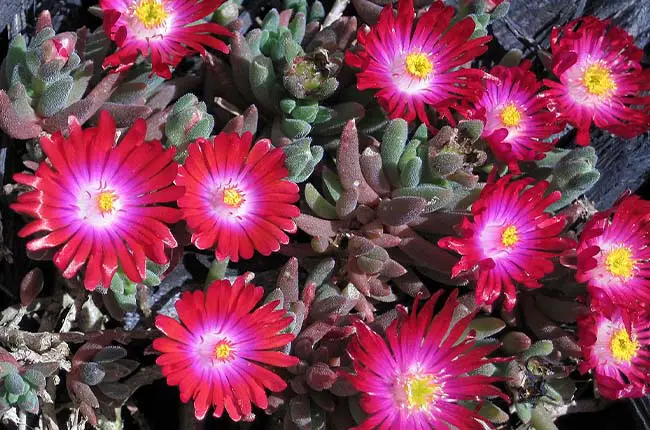
(James St. John, CC BY 2.0, via Wikimedia Commons)
2. Rock Purslane (Calandrinia spectabilis)
With silvery green leaves that grow close to the ground and bright purple cup-shaped flowers that bloom on tall stems, Rock Purslane is a great choice for ground cover in hot, dry climates.
The leaves and long stems grow from 1 – 2 feet (30 – 60 cm) tall, while each plant can reach a width of 3 – 4 feet (90 – 120 cm).
They spread quickly and need little maintenance and water – even during the hot summer months.
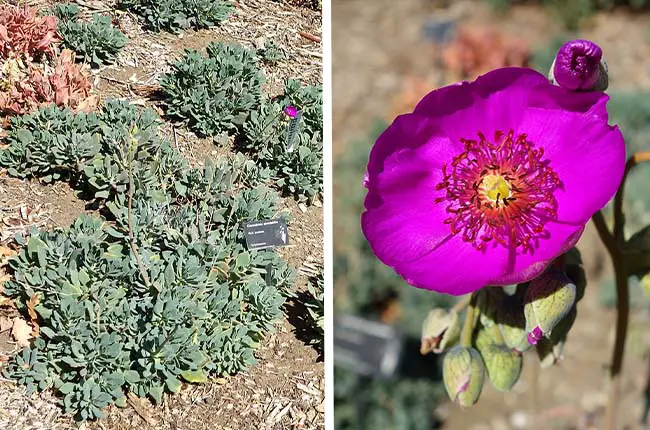
(Daderot, CC0, via Wikimedia Commons)
3. Caucasian Stonecrop (Sedum spurium)
Popular for its unique whorled, red-edged leaves, Caucasian Stonecrop grows low to the ground and is ideal for those in cooler climates. It grows in USDA Hardiness Zones 3 – 9, making it a versatile ground cover that thrives in a wide range of climates.
Caucasian Stonecrop is creeping, meaning that it spreads quickly across the ground. It can grow up to 3-6 inches tall (7-15 cm) and 12-18 inches wide (30-45 cm).
It makes for striking contrast with other plants – especially those with bold, vibrant colors.
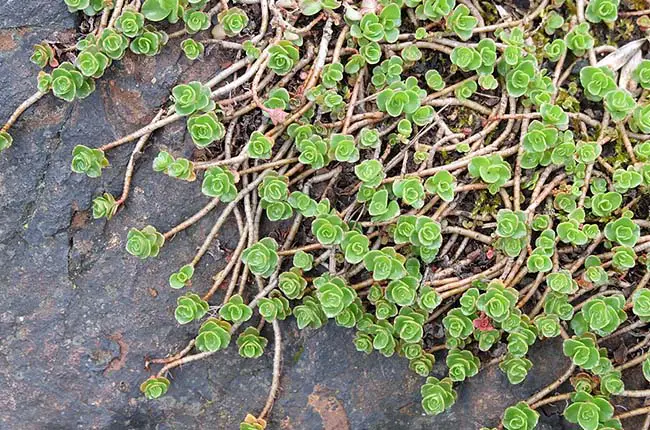
(Katrin Schneider, korina.info – CC-BY-SA-4.0, CC BY-SA 4.0, via Wikimedia Commons)
4. Royal Dewflower (Drosanthemum speciosum)
With bright, cheery blossoms that grow low to the ground, it’s easy to see why Royal Dewflower is popular as a ground cover.
This hardy ground cover tolerates cooler temperatures than many other succulents, able to withstand temperatures down to the freezing point.
It can grow up to 1 feet (30 cm) tall and spread to 3 feet (90 cm) across.
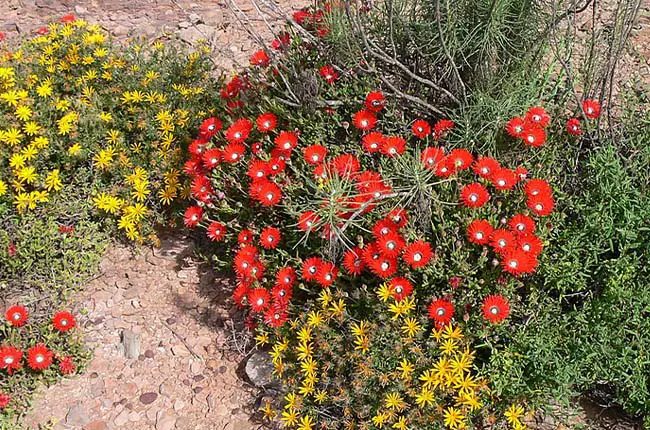
(Winfried Bruenken (Amrum), CC BY-SA 2.5, via Wikimedia Commons)
5. “Jewel of the Desert” Ice Plant (Delosperma cooperi)
Another Delosperma hybrid, this ice plant has longer, lighter green leaves than Fire Spinner and round, attractive garnet flowers with white or pink centers.
Jewel of the Desert particularly attracts pollinators such as bees, butterflies, and hummingbirds.
It spreads quickly after planting, about 4 – 6 inches (10 – 15 cm) wide.
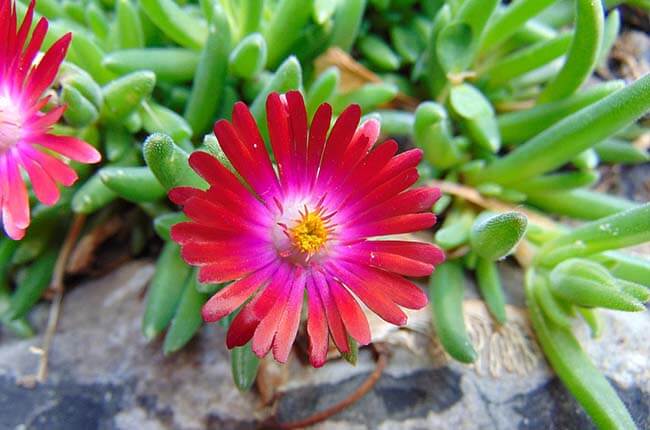
(Nadiatalent, CC BY-SA 4.0, via Wikimedia Commons)
6. Hens and Chicks (Sempervivum tectorum)
Also known as the common houseleek, Hens and Chicks are named for the small round rosettes that are produced around the main parent plant.
They spread quickly, spreading up to 2 – 3 feet (60 – 90 cm) per growing season.
When the parent plant dies, the offshoots become parent plants of their own and begin creating their own offshoots.
Hens and Chicks are usually green with some variation, such as red or white tips or edges.
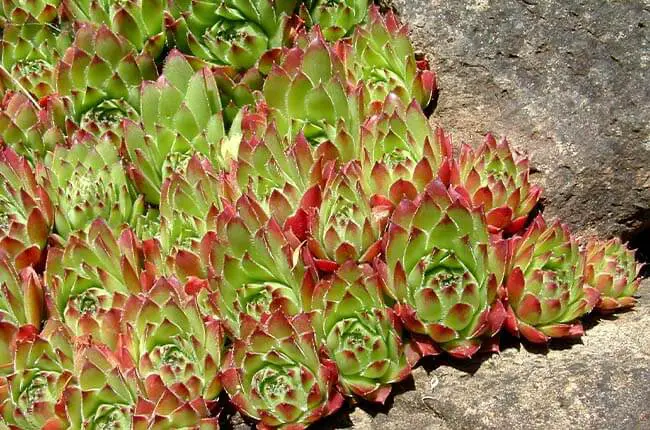
(Paul Harrison, CC BY-SA 4.0, via Wikimedia Commons) – same pic as in rosette article
Fast-Growing Succulent Shrubs
7. Candelilla (Euphorbia antisyphilitica)
The Candelilla is an upright, fast-growing shrub that can reach a mature height of about 3 feet (90 cm) and a width of 1-2 feet (30 – 60 cm).
It has long, thin, waxy stems devoid of leaves.
The small, tufted white flowers bloom year-round and grow along the candle-like stems (lending this plant its common name) giving it a tufted appearance.
Candelilla has a mildly toxic white sap and has been known to be fatal to cattle when ingested. Candelilla should be avoided as a ground cover for those with pets and small children.

(Amante Darmanin from Malta, CC BY 2.0, via Wikimedia Commons)
8. Mother of Thousands (Kalanchoe daigremontiana)
This shrubby succulent goes by many names, including the Alligator Plant, the Mexican Hat Plant, and Devil’s Backbone.
In the right conditions, it can grow quite quickly – up to 2 feet (60 cm) tall and 1 foot (30) wide after 2 – 5 years.
What makes Mother of Thousands unique is that it doesn’t reproduce by seed. Instead, it grows thousands of baby plantlets along its leaves that fall off and grow where they land when the parent plant dies. The baby plants appear first as tiny buds along the leaves and quickly unfurl into their own plants.
While this succulent makes for an attractive and quickly growing ground cover (especially in hot climates), it can become invasive due to the plantlets constantly falling and spawning new plants.
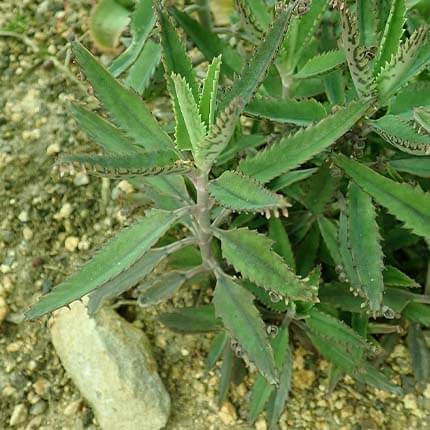
(Salicyna, CC BY-SA 4.0, via Wikimedia Commons)
9. Jade Plant (Crassula ovata)
One of the most popular succulents, the jade plant is named for its bright green color and smooth, rounded foliage.
While usually cultivated as a houseplant, jade plants flourish and grow quite large outside in the right climate – 3 to 6 feet (90-180 cm) tall and 2 – 3 feet (60-90 cm) wide.
The jade plant grows relatively slowly indoors but grows faster as an outdoor plant.
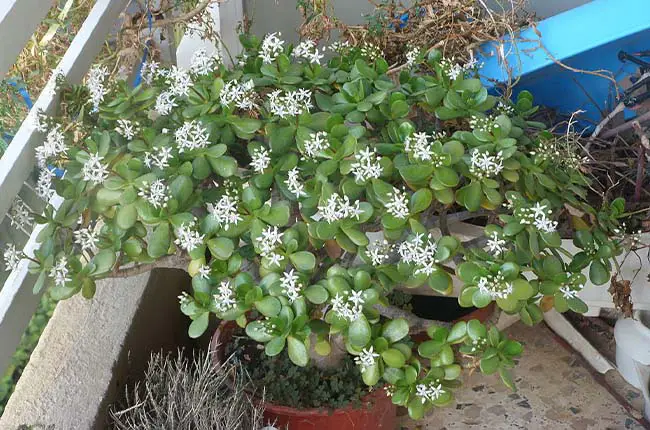
(Spyros Papanastasiou, CC0, via Wikimedia Commons)
10. Sticks on Fire (Euphorbia Tirucalli)
This popular succulent is known by many names, including Fire Sticks, Rosea, Red Pencil Plant, Milk Bush, and Finger Tree.
This Euphorbia species is named for its bright orange stems that grow upright and spread out, giving it a striking contrast against the green foliage of other plants.
It can grow up to 4 feet (1.2 meters) tall and 8 feet (3.2 meters) wide.
Sticks on Fire is not only popular for its color and shape, but it is also a low-maintenance evergreen that needs little water and flourishes in hot climates. It however has a toxic milky sap which should be avoided for gardens with pets and children.

(Alejandro Bayer Tamayo from Armenia, Colombia, CC BY-SA 2.0, via Wikimedia Commons)
Fast-Growing Succulent Ground Covers that Love Sun
11. Blue Chalksticks (Senecio serpens)
Native to South Africa and ideal for dry, Mediterranean climates without extreme temperatures, Blue Chalksticks is a great, fast-growing groundcover.
As its name suggests, Blue Chalksticks have long, spindly foliage that is blue-gray in color. It is a taller ground cover, so avoid this plant if you want close-cropped groundcover.
Each plant grows about 1 foot (30cm) tall and 2 – 3 feet (60 – 90 cm) wide.
Aside from being an attractive, shrubby succulent, Blue Chalksticks is also used in many areas for erosion control.
12. Parry’s Agave (Agave parryi)
Parry’s Agave – like most agave species – is native to the deserts of the American Southwest and Mexico. Its large, spoon-shaped, and spiky leaves are edged with dark brown spines that lend a stunning contrast against its powdery gray-blue foliage.
Parry’s Agave grows in a single round rosette that can reach a width of 3 feet (90 cm).
When the plant reaches the age of 10 – 15 years, a flower will bloom atop a stalk that can reach 20 feet (6 meters). tall, making it one of the largest entries on our list.
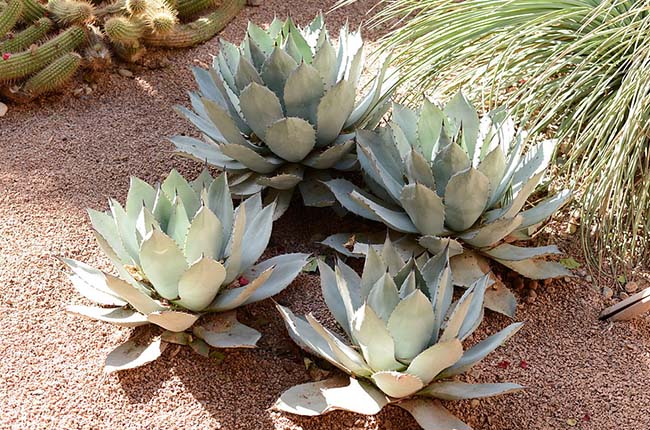
(Ruthven, CC0, via Wikimedia Commons)
13. Purple Heart (Tradescantia Pallida ‘Purpurea’)
Also called Purple Queen and Purple Spiderwort, Purple Heart is one of the most eye-catching entries on our list with deep violet lance-shaped leaves that resemble narrow boats. Tiny, pale pink flowers bloom during the spring and summer.
Purple Heart is native to Mexico and grows up to 12 – 18 inches (30 – 46 cm) in both height and width. Plant in full sun for the best and boldest color.
Unlike most succulents, Purple Heart requires more frequent watering but is generally tolerant to drought.
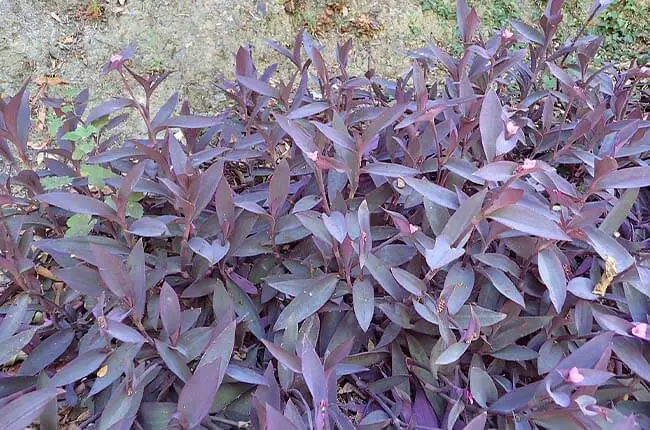
(Krzysztof Ziarnek, Kenraiz, CC BY-SA 4.0, via Wikimedia Commons)
Fast-Growing Ground Cover Succulents for Shade
14. Dragon Fruit Cactus (Hylocereus undatus)
Known for growing delicious and oddly shaped fruit, the Dragon Fruit Cactus grows in an umbrella shape, with cascading green stems that drape over halfway down the thick, woody trunk. The pink and yellow fruit grows from the green stems.
It grows quickly to a mature size of 13 feet (4 meters) in height to 6 feet (2 meters) in width.
The Dragon Fruit Cactus – also known as the Moonlight Cactus, Night Blooming Cereus, Strawberry Pear, and Honolulu Queen – is a fast-growing succulent, able to bear fruit 4 – 6 times in a single year in the right growing conditions.
The Dragon Fruit Cactus is native to the tropical climates of South and Central America and can only be grown in USDA hardiness zone 11.

(Forest & Kim Starr, CC BY 3.0, via Wikimedia Commons)
15. Joshua Tree (Yucca brevifolia)
This well-known succulent is native to the Mojave Desert in southern Nevada, southern Utah, southeastern California, and western Arizona.
Spiky growths sprout from the main trunks, and each tree can reach 40 ft tall or even more. Dense clusters of egg-shaped whitish-green blooms sprout at the end of each stem and bloom during the spring and summer.
While older, mature Joshua Trees only grow between 9 – 11 cm per year, young trees grow quicker with thick, spiky tubercules that are each coated in thin, papery brownish leaves that differ from the spikes in stiffness.
If grown 10 – 12 ft apart, Joshua Trees will slowly grow wider and close the gaps, making a tall, spiky ground cover.
16. Candelabra Tree (Euphorbia ingens)
Named for its unique shape, the low-maintenance Candelabra Tree grows dozens (even hundreds in the case of larger trees) of firm green tubercules that grow upright. Older trees have a thick, woody trunk, from which the top grow the tubercules and can reach a height of 40 ft outdoors.
Shorter Candelabra Trees can grow in clusters close together with tubercules overlapping each other, creating a backdrop against which shorter plants can grow.
The Candelabra Tree is drought-resistant and bloom during the fall and winter, bringing a splash of color to the dull winter months. They only grow in hot climates, in USDA hardiness zones 10 – 11.
Keep in mind that the Candelabra Tree is toxic to humans and animals, so it should be avoided by those who have children and pets.
Related
26 Succulents With Spiky Leaves
36 Rosette-Shaped Succulents (With Pictures)
14 Fragrant Succulents & Cacti
Featured photo credits: cultivar413, CC BY 2.0, via Wikimedia Commons
- Keiki Paste vs Rooting Hormone:What’s the difference? - February 4, 2024
- Top 10 Orchid Fertilizers: A Comprehensive Review (2024) - February 2, 2024
- Top 8 Soil Inoculants For Stronger Plants (2024) - February 1, 2024


